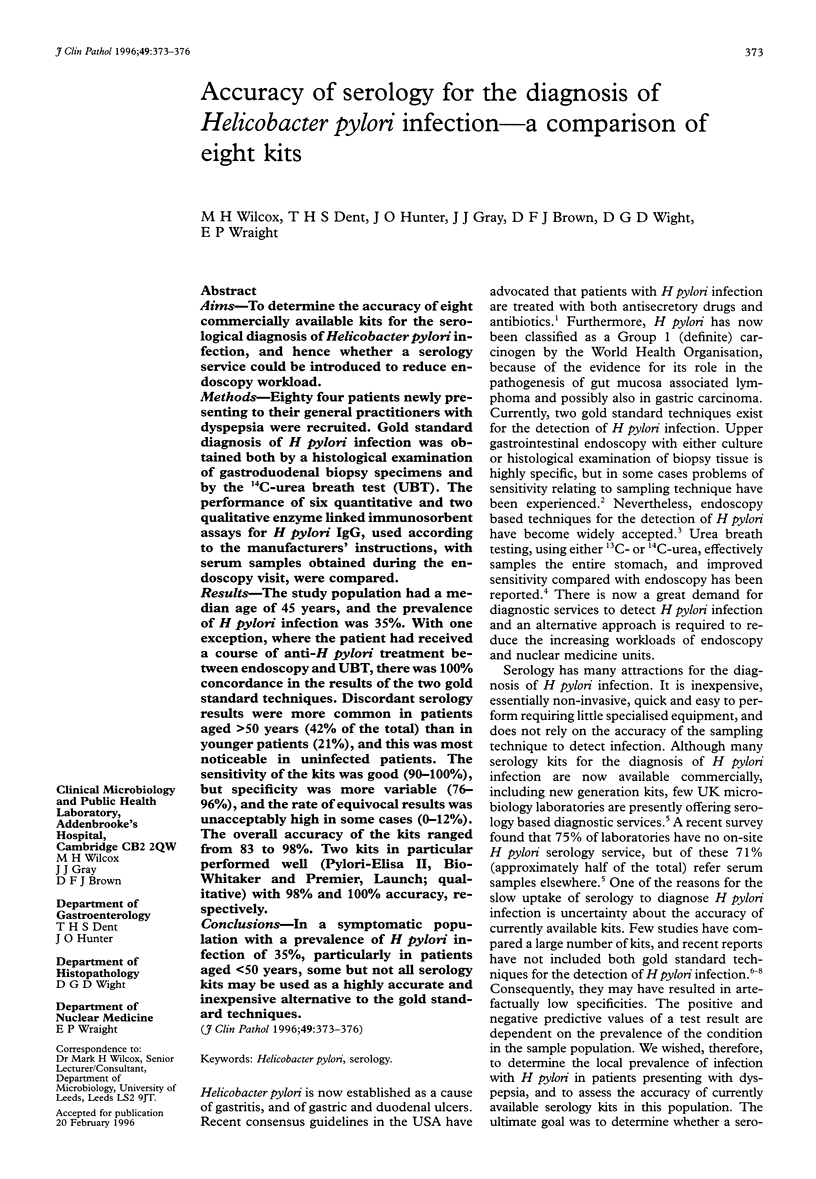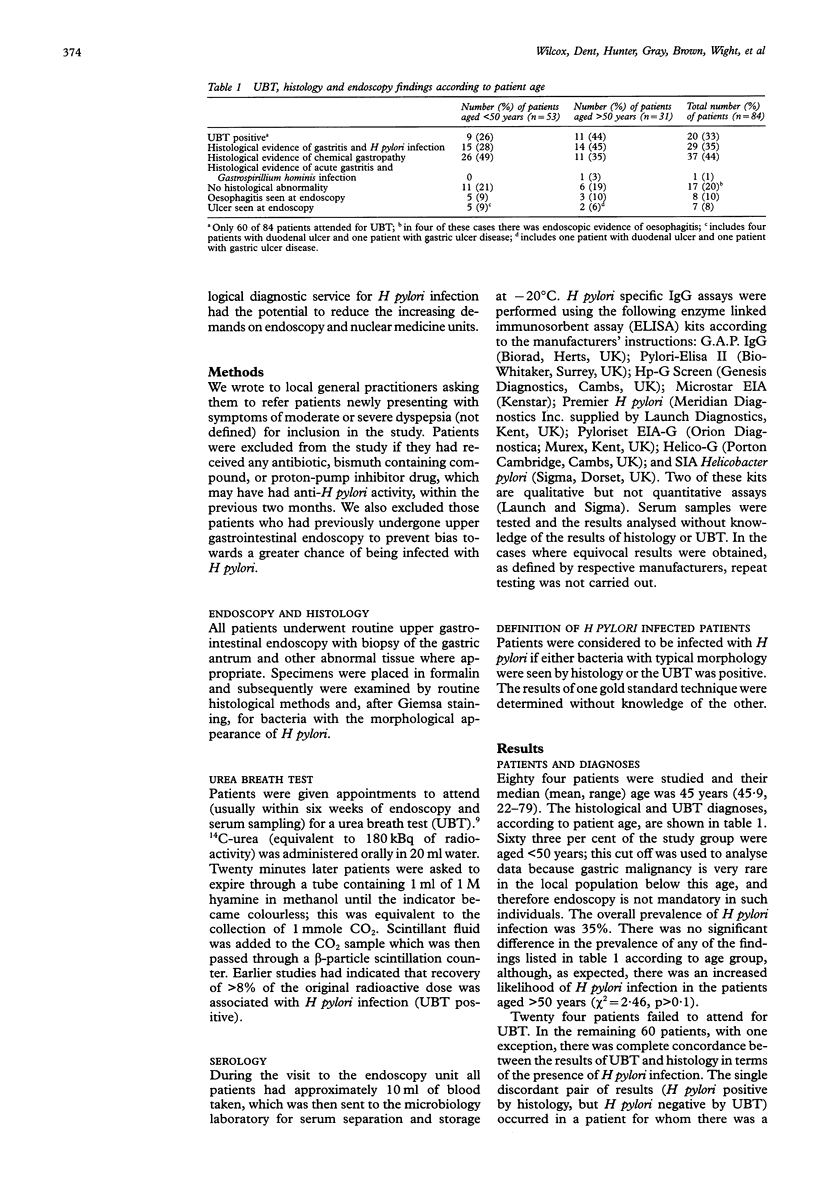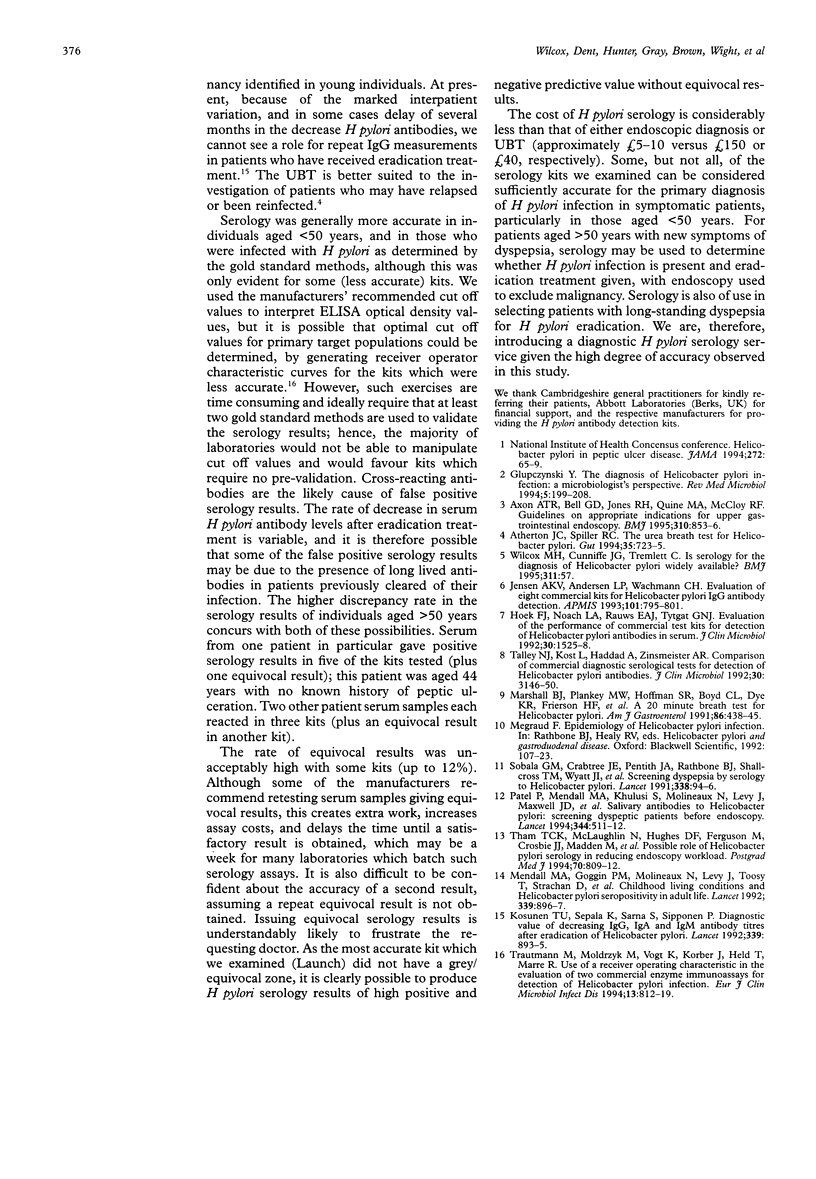Abstract
AIMS: To determine the accuracy of eight commercially available kits for the serological diagnosis of Helicobacter pylori infection, and hence whether a serology service could be introduced to reduce endoscopy workload. METHODS: Eighty four patients newly presenting to their general practitioners with dyspepsia were recruited. Gold standard diagnosis of H pylori infection was obtained both by a histological examination of gastroduodenal biopsy specimens and by the 14C-urea breath test (UBT). The performance of six quantitative and two qualitative enzyme linked immunosorbent assays for H pylori IgG, used according to the manufacturers' instructions, with serum samples obtained during the endoscopy visit, were compared. RESULTS: The study population had a median age of 45 years, and the prevalence of H pylori infection was 35%. With one exception, where the patient had received a course of anti-H pylori treatment between endoscopy and UBT, there was 100% concordance in the results of the two gold standard techniques. Discordant serology results were more common in patients aged > 50 years (42% of the total) than in younger patients (21%), and this was most noticeable in uninfected patients. The sensitivity of the kits was good (90-100%), but specificity was more variable (76-96%), and the rate of equivocal results was unacceptably high in some cases (0-12%). The overall accuracy of the kits ranged from 83 to 98%. Two kits in particular performed well (Pylori-Elisa II, Bio-Whitaker and Premier, Launch; qualitative) with 98% and 100% accuracy, respectively. CONCLUSIONS: In a symptomatic population with a prevalence of H pylori infection of 35%, particularly in patients aged < 50 years, some but not all serology kits may be used as a highly accurate and inexpensive alternative to the gold standard techniques.
Full text
PDF



Selected References
These references are in PubMed. This may not be the complete list of references from this article.
- Atherton J. C., Spiller R. C. The urea breath test for Helicobacter pylori. Gut. 1994 Jun;35(6):723–725. doi: 10.1136/gut.35.6.723. [DOI] [PMC free article] [PubMed] [Google Scholar]
- Axon A. T., Bell G. D., Jones R. H., Quine M. A., McCloy R. F. Guidelines on appropriate indications for upper gastrointestinal endoscopy. Working Party of the Joint Committee of the Royal College of Physicians of London, Royal College of Surgeons of England, Royal College of Anaesthetists, Association of Surgeons, the British Society of Gastroenterology, and the Thoracic Society of Great Britain. BMJ. 1995 Apr 1;310(6983):853–856. doi: 10.1136/bmj.310.6983.853. [DOI] [PMC free article] [PubMed] [Google Scholar]
- Hoek F. J., Noach L. A., Rauws E. A., Tytgat G. N. Evaluation of the performance of commercial test kits for detection of Helicobacter pylori antibodies in serum. J Clin Microbiol. 1992 Jun;30(6):1525–1528. doi: 10.1128/jcm.30.6.1525-1528.1992. [DOI] [PMC free article] [PubMed] [Google Scholar]
- Jensen A. K., Andersen L. P., Wachmann C. H. Evaluation of eight commercial kits for Helicobacter pylori IgG antibody detection. APMIS. 1993 Oct;101(10):795–801. [PubMed] [Google Scholar]
- Kosunen T. U., Seppälä K., Sarna S., Sipponen P. Diagnostic value of decreasing IgG, IgA, and IgM antibody titres after eradication of Helicobacter pylori. Lancet. 1992 Apr 11;339(8798):893–895. doi: 10.1016/0140-6736(92)90929-w. [DOI] [PubMed] [Google Scholar]
- Marshall B. J., Plankey M. W., Hoffman S. R., Boyd C. L., Dye K. R., Frierson H. F., Jr, Guerrant R. L., McCallum R. W. A 20-minute breath test for helicobacter pylori. Am J Gastroenterol. 1991 Apr;86(4):438–445. [PubMed] [Google Scholar]
- Mendall M. A., Goggin P. M., Molineaux N., Levy J., Toosy T., Strachan D., Northfield T. C. Childhood living conditions and Helicobacter pylori seropositivity in adult life. Lancet. 1992 Apr 11;339(8798):896–897. doi: 10.1016/0140-6736(92)90931-r. [DOI] [PubMed] [Google Scholar]
- Patel P., Mendall M. A., Khulusi S., Molineaux N., Levy J., Maxwell J. D., Northfield T. C. Salivary antibodies to Helicobacter pylori: screening dyspeptic patients before endoscopy. Lancet. 1994 Aug 20;344(8921):511–512. doi: 10.1016/s0140-6736(94)91899-6. [DOI] [PubMed] [Google Scholar]
- Sobala G. M., Crabtree J. E., Pentith J. A., Rathbone B. J., Shallcross T. M., Wyatt J. I., Dixon M. F., Heatley R. V., Axon A. T. Screening dyspepsia by serology to Helicobacter pylori. Lancet. 1991 Jul 13;338(8759):94–96. doi: 10.1016/0140-6736(91)90085-4. [DOI] [PubMed] [Google Scholar]
- Talley N. J., Kost L., Haddad A., Zinsmeister A. R. Comparison of commercial serological tests for detection of Helicobacter pylori antibodies. J Clin Microbiol. 1992 Dec;30(12):3146–3150. doi: 10.1128/jcm.30.12.3146-3150.1992. [DOI] [PMC free article] [PubMed] [Google Scholar]
- Tham T. C., McLaughlin N., Hughes D. F., Ferguson M., Crosbie J. J., Madden M., Namnyak S., O'Connor F. A. Possible role of Helicobacter pylori serology in reducing endoscopy workload. Postgrad Med J. 1994 Nov;70(829):809–812. doi: 10.1136/pgmj.70.829.809. [DOI] [PMC free article] [PubMed] [Google Scholar]
- Trautmann M., Moldrzyk M., Vogt K., Körber J., Held T., Marre R. Use of a receiver operating characteristic in the evaluation of two commercial enzyme immunoassays for detection of Helicobacter pylori infection. Eur J Clin Microbiol Infect Dis. 1994 Oct;13(10):812–819. doi: 10.1007/BF02111341. [DOI] [PubMed] [Google Scholar]


